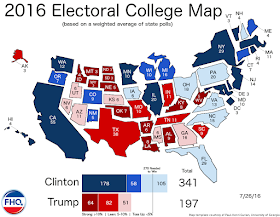There were a couple of late day polls released on the opening day of the Democratic convention. Neither of them did much to shake up the map or the spectrum below.
Georgia:
The first was a Landmark/WSB survey from the Peach state where a handful of 2016 polls have shown a race that is more competitive between Clinton and Trump than was the case in the general election four years ago. This poll only confirmed that trend. In fact, Trump's two point advantage was just a fraction under the previous FHQ average in Georgia. Georgia may be closer than is years past, but the direction of the polling thus far in 2016 has with only one exception been point toward the New York businessman. While that has been consistent, there has nonetheless been volatility in terms of each candidates' share of polling support in the state as is typical of an election cycle with no incumbent running.
Nevada:
In the polls Georgia has moved toward the Democrats since 2012, but Nevada has shifted in the direction of the Republican Party in the presidential election polling conducted in the Silver state. Now, there has not been a lot of survey work done in Nevada, but what little has been done has shown a race between Clinton and Trump that is about eight points more Republican than the state was in November 2012. That trend line was buttressed by the inter-convention survey of the state from KTNV/Rasmussen. Trump's five point advantage keeps Nevada on the Republican side of the spectrum below but still squarely in toss up territory for the moment.
The Electoral College Spectrum1
| ||||
HI-42
(7)
|
WA-12
(164)
|
NH-4
(253)
|
KS-6
(158)
|
LA-8
(55)
|
VT-3
(10)
|
NJ-14
(178)
|
PA-203
(273/285)
|
UT-6
(152)
|
SD-3
(47)
|
MD-10
(20)
|
WI-10
(188)
|
IA-6
(279/265) |
AK-3
(146)
|
ND-3
(44)
|
RI-4
(24)
|
OR-7
(195)
|
FL-29
(308/259) |
MO-10
(143)
|
ID-4
(41)
|
MA-11
(35)
|
NM-5
(200)
|
NC-15
(323/230)
|
IN-11
(133)
|
NE-5
(37)
|
CA-55
(90)
|
CT-7
(207)
|
OH-18
(341/215)
|
TX-38
(122)
|
AL-9
(32)
|
DE-3
(93)
|
ME-4
(211)
|
AZ-11
(197)
|
SC-9
(84)
|
KY-8
(23)
|
NY-29
(122)
|
CO-9
(220)
|
NV-6
(186)
|
TN-11
(75)
|
WV-5
(15)
|
IL-20
(142)
|
MI-16
(236)
|
GA-16
(180)
|
AR-6
(64)
|
OK-7
(10)
|
MN-10
(152)
|
VA-13
(249)
|
MS-6
(164)
|
MT-3
(58)
|
WY-3
(3)
|
1 Follow the link for a detailed explanation on how to read the Electoral College Spectrum.
2 The numbers in the parentheses refer to the number of electoral votes a candidate would have if he or she won all the states ranked prior to that state. If, for example, Trump won all the states up to and including Pennsylvania (all Clinton's toss up states plus Pennsylvania), he would have 285 electoral votes. Trump's numbers are only totaled through the states he would need in order to get to 270. In those cases, Clinton's number is on the left and Trumps's is on the right in bold italics. To keep the figure to 50 cells, Washington, DC and its three electoral votes are included in the beginning total on the Democratic side of the spectrum. The District has historically been the most Democratic state in the Electoral College. 3 Pennsylvania is the state where Clinton crosses the 270 electoral vote threshold to win the presidential election. That line is referred to as the victory line. | ||||
NOTE: Distinctions are made between states based on how much they favor one candidate or another. States with a margin greater than 10 percent between Clinton and Trump are "Strong" states. Those with a margin of 5 to 10 percent "Lean" toward one of the two (presumptive) nominees. Finally, states with a spread in the graduated weighted averages of both the candidates' shares of polling support less than 5 percent are "Toss Up" states. The darker a state is shaded in any of the figures here, the more strongly it is aligned with one of the candidates. Not all states along or near the boundaries between categories are close to pushing over into a neighboring group. Those most likely to switch -- those within a percentage point of the various lines of demarcation -- are included on the Watch List below.
The Watch List1
| |||
State
|
Switch
| ||
|---|---|---|---|
Alaska
|
from Lean Trump
|
to Toss Up Trump
| |
Arizona
|
from Toss Up Trump
|
to Toss Up Clinton
| |
Arkansas
|
from Strong Trump
|
to Lean Trump
| |
New Hampshire
|
from Toss Up Clinton
|
to Lean Clinton
| |
New Jersey
|
from Strong Clinton
|
to Lean Clinton
| |
Pennsylvania
|
from Toss Up Clinton
|
to Lean Clinton
| |
Tennessee
|
from Lean Trump
|
to Strong Trump
| |
Utah
|
from Toss Up Trump
|
to Lean Trump
| |
Virginia
|
from Toss Up Clinton
|
to Lean Clinton
| |
1 Graduated weighted average margin within a fraction of a point of changing categories.
| |||
Recent Posts:
The Electoral College Map (7/25/16)
The Democrats' Unity Reform Commission
The Electoral College Map (7/23/16)
Follow FHQ on Twitter, Google+ and Facebook or subscribe by Email.


No comments:
Post a Comment